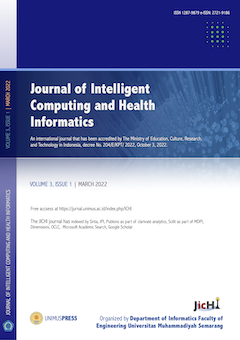Optimization of Skin Cancer Detection to Improve Accuracy with the Application of Efficient Convolutional Neural Network and EfficientNetB2 Models
(1) University of Muhammadiyah Semarang
(2) Universitas Muhammadiyah Semarang
(3) Universitas Muhammadiyah Semarang
(*) Corresponding Author
Abstract
Keywords
References
Hendaria, M. P., Asmarajaya, A., & Maliawan, S. (2013). Kanker kulit. Universitas Udayana.
Fu’adah, Y. N., Pratiwi, N. C., Pramudito, M. A., & Ibrahim, N. (2020). Convolutional neural network (CNN) for automatic skin cancer classification system. IOP Conference Series: Materials Science and
Engineering, 982(1), 0–10. https://doi.org/10.1088/1757- 899X/982/1/012005
Esteva, A., Kuprel, B., Novoa, R. A., Ko, J., Swetter, S. M., Blau, H. M., & Thrun, S. (2017). Dermatologist-level classification of skin cancer with deep neural networks. Nature, 542 (7639), 115–118.
Munthe, T. L. D. (2018). Klasifikasi citra kanker kulit berdasarkan tingkat keganasan kanker pada melanosit menggunakan deep convolutional neural network (DCNN). Repositori Institusi Universitas Sumatera Utara (RI-USU), 44–48.
Savera, T. R., Suryawan, W. H., & Setiawan, A. W. (2020). Deteksi dini kanker kulit menggunakan K-NN dan early detection of skin cancer using K-Nn and convolutional. 7 Klasifikasi Kanker Kulit Menggunakan Metode Convolutional Neural Network dengan Arsitektur VGG-16 ELKOMIKA – 457 (2), 373–378. https://doi.org/10.25126/jtiik.202072602
F. F. Maulana and N. Rochmawati, “Klasifikasi Citra Buah Menggunakan Convolutional Neural Network,” J. Informatics Comput. Sci., vol. 01, no. 02, pp. 104–108, 2019.
Tan, M. and Le, Q. V., 2021. EfficientNetV2: Smaller Model and Faster Training, [online] Available at: .
Tan, M., Pang, R., and Le, Q. V. Efficientdet: Scalable and efficient object detection. CVPR, 2020
Albattah, W., Javed, A., Nawaz, M., Masood, M. and Albahli, S., 2022. Artificial Intelligence-Based Drone System for Multiclass Plant Disease Detection Using an Improved Efficient Convolutional Neural
Network. Frontiers in Plant Science, 13 (June). https://doi.org/10.3389/fpls.2022.808380.
Bello, I. Lambdanetworks: Modeling long-range interactions without attention. ICLR, 2021.
Bello, I., Fedus, W., Du, X., Cubuk, E. D., Srinivas, A., Lin, T.-Y., Shlens, J., and Zoph, B. Revisiting
resnets: Improved training and scaling strategies. arXiv preprint arXiv:2103.07579, 2021..
Brock,A.,De,S.,Smith,S.L.,andSimonyan,K.Highperformancelarge-scaleimagerecognitionwithout
normalization. arXiv preprint arXiv:2102.06171, 2021.
Akram, A., Fayakun, K., & Ramza, H. (2023). Klasifikasi Hama Serangga pada Pertanian Menggunakan
Metode Convolutional Neural Network. Building of Informatics, Technology and Science (BITS), 5(2).
https://doi.org/10.47065/bits.v5i2.4063
M. I. Mardiyah, “Implementasi Deep Learning untuk Image Classification Menggunakan Algoritma
Convolutional Neural Network (CNN) Pada Citra Kebun dan Sawah,” Universitas Islam Indonesia, 2020.
K. H. Mahmud, Adiwijaya, and S. Al Faraby, “Klasifikasi Citra Multi-Kelas Menggunakan
Convolutional Neural Network,” in e-Proceeding of Engineering, 2019, vol. 6, no. 1, pp. 2127–2136
D. Husen, K. Kusrini, dan K. Kusnawi, “Deteksi Hama pada Daun Apel Menggunakan Algoritma Convolutional Neural Network,” J. Media Inform. Budidarma, vol. 6, no. 4, hal. 2103–2110, 2022, doi:
30865/mib.v6i4.4667.
R. Shinta, Jasril, M. Irsyad, F. Yanto, dan S. Sanjaya, “Klasifikasi Citra Penyakit Daun Tanaman Padi
Menggunakan CNN dengan Arsitektur VGG-19,” J. Sains dan Inform., vol. 9, no. 1, hal. 37–45, 2023,
doi: 10.22216/jsi.v9i1.2175.
D. Irfansyah, M. Mustikasari, dan A. Suroso, “Arsitektur Convolutional Neural Network (CNN) Alexnet
untuk Klasifikasi Hama pada Citra Daun Tanaman Kopi,” J. Inform. J. Pengemb. IT, vol. 6, no. 2, hal. 87–92, 2021, [Daring]. Tersedia pada: http://ejournal.poltektegal.ac.id/index.php/informatika/article/view/2802
Tan, M. and Le, Q. V. Efficientnet: Rethinking model scaling for convolutional neural networks. ICML, 2019a.
Article Metrics
Abstract view : 80 timesDOI: https://doi.org/10.26714/jichi.v5i2.14338
Refbacks
- There are currently no refbacks.
____________________________________________________________________________
Journal of Intelligent Computing and Health Informatics (JICHI)
ISSN 2715-6923 (print) | 2721-9186 (online)
Organized by
Department of Informatics
Faculty of Engineering
Universitas Muhammadiyah Semarang
W : https://jurnal.unimus.ac.id/index.php/ICHI
E : [email protected], [email protected]








